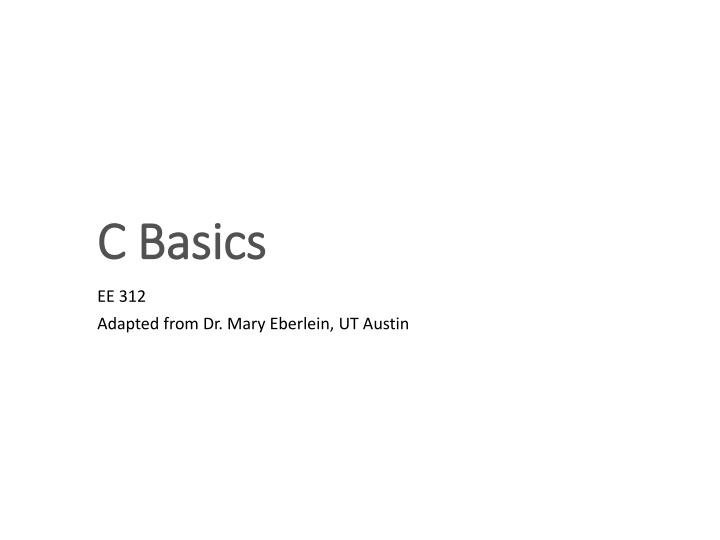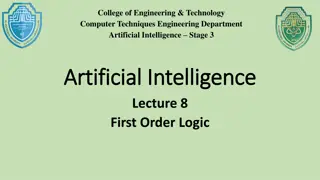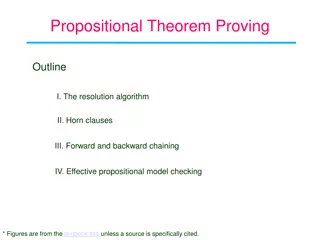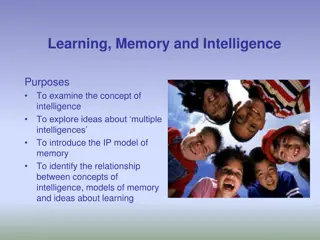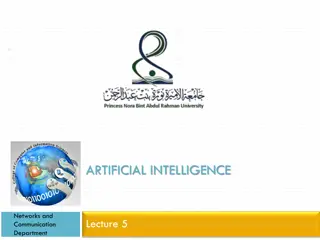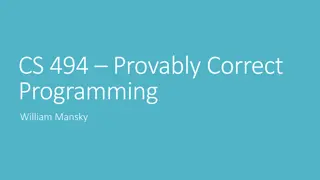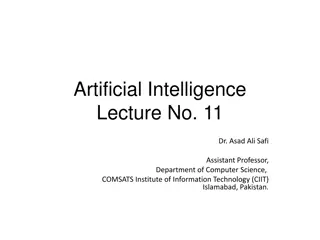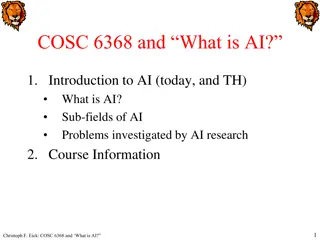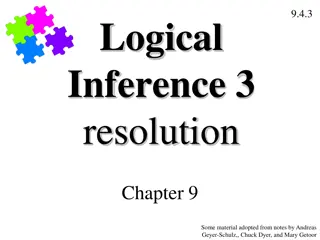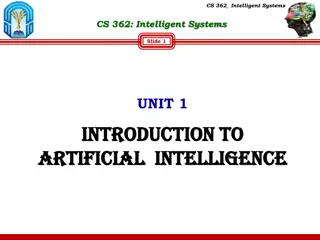Logic Programming and Resolution in Artificial Intelligence
Lecture notes covering logic programming using Prolog, backward chaining, query examples, infinite loops in directed graphs, redundant inference, and resolution rules in artificial intelligence.
Download Presentation

Please find below an Image/Link to download the presentation.
The content on the website is provided AS IS for your information and personal use only. It may not be sold, licensed, or shared on other websites without obtaining consent from the author.If you encounter any issues during the download, it is possible that the publisher has removed the file from their server.
You are allowed to download the files provided on this website for personal or commercial use, subject to the condition that they are used lawfully. All files are the property of their respective owners.
The content on the website is provided AS IS for your information and personal use only. It may not be sold, licensed, or shared on other websites without obtaining consent from the author.
E N D
Presentation Transcript
C Basics C Basics EE 312 Adapted from Dr. Mary Eberlein, UT Austin
C: A low C: A low- -level language level language C does not have: exceptions for error-handling range-checking garbage collection OO programming String type low level faster (usually) So... be careful: Recommendations Learn a debugger like gdb (more about this later) Use libraries of existing code (both to save time and increase reliability). Adopt a sensible set of coding conventions. Avoid programming tricks and complicated code.
C Standards C Standards Three C Standards: 1. ANSI C: from late 80s (aka C89) 2. C99: standard from 1999 New built-in types (e.g., _Bool) stdbool.h provides bool Added variable-length arrays, single line comments, declarations and code mixing 3. C11: current standard, released in 2011 Improved Unicode support (char16_t, char32_t types for storing UTF-16, UTF-32 encoded data)
High Level Languages Assembly language: better than sequences of bits lots of commands to accomplish things High Level Computer Languages: accomplish a lot with fewer commands compared to machine or assembly language easier to understand instructions translated/compiled into machine instructions int sum = 0; int count = 0; while( list[count] != -1 ) { sum += list[count]; count = count + 1; } 4
Structure of a C Program Structure of a C Program #include<something.h> int main(void) { <statement>; <statement>; ... <statement>; } Stored in .c file Every executable C program contains main function containing statements to be executed function: a named group of statements statement: a command to be executed
Build Process with Build Process with gcc Source Code to Executable Source Code to Executable gcc Two types of source code files: regular code (files end in .c) header files (files end in .h) Compiler turns source code into object code files end in .o Linker turns object code files into executable a.out by default
Source Code to Executable Source Code to Executable gcc program is compiler and linker % gcc hello.c o hello What happens? gcc does this: compiles hello.c to hello.o links hello.o with system libraries produces binary executable hello -Wall enables compiler warnings gcc Wall o hello hello.c -g embeds debugging info gcc g hello.c
Compilation with Compilation with gcc gcc GNU C Compiler gcc: included on unix Available via MinGW or Cygwin on Windows Specify output file with o option (default is a.ou gcc compilation process % gcc hello.c % ./a.out Hello World Richard Stallman, founder of the GNU project % gcc o hello hello.c % ./hello Hello World source code (.c, .h) Preprocessing Include header, expand macro (.i) Compilation Assembly code (.S) Assembler Machine code (.o) Linking executable
Compilation with Compilation with gcc gcc gcc options can be used to determine how far to go in build process source code (.c, .h) Preprocessing Include header, expand macro (.i) -E Compilation -S Assembly code (.S) Assembler -c Machine code (.o) Linking gcc c hello.c o hello.o machine code in file hello.o gcc E hello.c o hello.i preprocessed file in hello.i executable
Build Summary Build Summary Preprocessing: 1st pass of C compilation processes include files & macros Compilation: takes preprocessed code and generates assembly code (.S) Assembly: produces object file (.o) Linking: takes all object files, libraries and combines to get executable file gcc flags: indicate which steps to carry out
gdb gdb: command line debugger : command line debugger Useful commands break linenumber create breakpoint at specified line run run program c continue execution step execute next line or step into function quit quit gdb print expression print current value of expression l list program
CLion CLion: Integrated Development Environment : Integrated Development Environment Free for students Install on your machine You can choose to use a different IDE You are strongly encouraged to use CLion
Text Editor & Command Line Compilation Text Editor & Command Line Compilation Pick one... emacs vi Notepad++ (Windows) Compiler: gcc Make sure that your projects run correctly when compiled with gcc on the 64 bit ECE linux machines
General layout An example C Programs:
A C Program A C Program A C program contains: comments describe program in English include section C is small Need external libraries to do much Include header files to indicate what external code to use stdio library: contains code for reading and writing data from/to terminal, e.g., printf, puts for writing data to terminal scanf for reading data from terminal function prototypes main + other functions
#include macro macro Header files: constants, functions, other declarations #include<stdio.h> - read contents of header file stdio.h stdio.h: standard I/O functions for console, files Other important header files: math.h, stdlib.h, string.h, time.h
Symbolic Constants: Symbolic Constants: const (Better than macro) (Better than macro) const Variable Variable const variable is type checked by compiler. For compiled code with any modern compiler, zero performance difference between macros and constants. Examples: const int EOF = -1; const float TWO_PI = 2*3.14159; Naming convention for constants: All cap words separated by underscores TWO_PI CONVERSION_FACTOR
main and other functions and other functions C code contained in functions function: named chunk of code that carries out some task Use functions to break large program into small, self-contained & cohesive units Reduces program complexity Increases reusability of code main most important function where execution of your program begins
Functions Functions Function should carry out specific, well-defined task C program = 1 or more functions, including main return-type name(type1 parm1, type2 parm2, ... ) { // function body }
main function function main(): where execution begins Simple version: no inputs, returns 0 when successful and non-zero to signal error int main() Two argument form of main(): provides access to command-line arguments int main(int argc, char *argv[]) More on this later...
Function Prototypes Function Prototypes Declare functions before using Declaration called function prototype Examples of function prototypes: orint sumEm(int n, int m); int sumEm(int, int); Prototypes for common functions in header files in C Standard Library General prototype form: return_type function_name(type1, type2, ....); typei is type of argument i arguments: local variables, values passed from caller return value: value returned to calling function when function exits
We are EE 312 We are EE 312 /* Print message "We are EE 312" */ #include<stdio.h> int main() { // print text to console puts("We are EE 312!"); return 0; // 0 means success } puts(): output text to console window (stdout) and end the line String literal: enclosed in double quotes
We are EE 312, revised We are EE 312, revised /* Print message "We are EE 312" */ #include<stdio.h> int main() { const char msg[] = "We are EE 312!"; puts(msg); // print text to console return 0; // 0 means success } const: variable is a constant char: data type representing a single character char literals enclosed in single quotes: 'a', 't', '$' const char msg[]: a constant array of characters int return value is error code: normal exit if 0, problem if non-zero C standard: implied return of 0 at end of main
Example Example #include<stdio.h> int sumEm(int, int); int main() { int x = 3; int y = 5; int sum = sumEm(x, y); printf("The sum is %i\n", sum); } int sumEm(int num1, int num2) { int theSum = num1 + num2; return theSum; } Output: The sum is 8
Console I/O Console I/O stdout, stdin: console output & input streams char = getchar(): return character from stdin Later: scanf() puts(string): print string to stdout putchar(char): print character to stdout printf("format-string", list-of-values);
Console I/O Console I/O printf format string contains conversion specifications that correspond to type of values to print: %i: print integer value %g: print floating point number in general format %s: print a string %c: print a char printf("Name: %s, favorite integer: %i\n", Priebe", 42); printf("13.0/5 = %g\n", 13.0/5); Output: Name: Priebe, favorite integer: 42 13.0/5 = 2.6
Variables, Operators, and Types And some other C Basics...
Escape sequences escape sequence: A special sequence of characters used to represent certain special characters in a string. \t tab character \n new line character \" quotation mark character \\ backslash character Example: printf("\\hello\nhow\tare \"you\"?\\\\"); Output: \hello how are "you"?\\ 28
Question How many visible characters does the following printf statement produce when run? printf("\t\nn\\\t\"\tt"); A. 0 B. 1 C. 2 D. 3 E. 4 29
Practice Program What is the output of the following printf statements? printf("\ta\tb\tc"); printf("\\\\"); printf("'"); printf("\"\"\""); printf("C:\nin\the downward spiral"); 30
Answer to Practice Program Output of each println statement: a b c \\ ' """ C: in he downward spiral 31
Comments Comments Comments increase readability of code ignored by compiler Two forms: /* Everything here is a comment */ // Everything to end of line is a comment added in C99
Datatypes Datatypes The datatype of an object in memory determines the set of values it can have and what operations can be performed on it. C is a weakly typed language. allows implicit conversions forced (possibly dangerous) casting
C's built-in types primitive types: simple types for numbers, characters C++ also has object types, which we'll talk about later Name int double char Description integers real numbers single text characters (up to 231 - 1) 42, -3, 0, 926394 (up to 10308) 3.1, -0.25, 9.4e3 'a', 'X', '?', '\n' Examples
Built Built- -in Data Types in C in Data Types in C type: a category or set of data values constrains operations that can be performed on data Numeric types Integer Examples: int (signed by default): Typically 4 bytes leftmost bit indicates sign in two's complement format Range: -231 to 231-1 unsigned int Range: 0 to 232-1 long char: 1 byte 'A', '7' Floating point float: single point precision (typically 4 bytes) double: double point precision (typically 8 bytes) long double: extended precision
Typical Integer Value Ranges Data Type Smallest Value Largest Value 16 bits short int -32,768 32,767 unsigned short int 0 65,535 32 bits int -2,147,483,648 2,147,483,647 unsigned int 0 4,294,967,295 32 bits long int -2,147,483,648 2,147,483,647 unsigned long int 0 4,294,967,295 Actual size of integer types varies by implementation Standard provides minimum sizes for data types, and requirements about relative size: char: at least one byte short and int: at least 2 bytes long: at least 4 bytes long long: at least 8 bytes Size restrictions: sizeof(long long) >=sizeof(long) >= sizeof(int) >= sizeof(short) >= sizeof(char)
Integer Overflow Integer Overflow Result of arithmetic operation on integers outside range of values that can be represented Yields incorrect results See ch 7 for more details
Fixed Fixed- -Width Integer Types Width Integer Types Enhance portability since sizes of integer types vary with implementation Included in C99 standard Very useful in embedded systems where hardware only supports some types Defined in inttypes.h and stdint.h header files intN_t: in interval [INTN_MIN, INTN_MAX] uintN_t: in interval [0, UINTN_MAX]
Floating Point Types Floating Point Types float: often IEEE 754 single-precision FP format double: often IEEE 754 double-precision FP long double: might be IEEE 754 quadruple-precision FP format could be the same as double Sizes vary by implementation Relative size restrictions: sizeof(long double) >= sizeof(double) >= sizeof(float)
Data Type Sizes Data Type Sizes types are different sizes, depending on platform How do you know? C standard library: limits.h // ranges for integer types (including char) float.h // ranges for floats and doubles Example: Write a program that prints the max and min values for int and float, as well as the size in bytes of both types
Expressions expression: A combination of values and / or operations that results (via computation) in a value. Examples: 1 + 4 * 5 (7 + 2) * 6 / 3 42 "Hello, world!" The simplest expression is a literal value. A complex expression can use operators and parentheses.
Arithmetic operators operator: Combines multiple values or expressions. + addition - subtraction (or negation) * multiplication / division % modulus (a.k.a. remainder) As a program runs, its expressions are evaluated. 1 + 1 evaluates to 2 printf("%d", 3 * 4); prints 12 How would we print the text 3 * 4 ?
Integer division with / When we divide integers, the quotient is also an integer. 14 / 4 is 3, not 3.5 3 4 52 4 ) 14 10 ) 45 27 ) 1425 12 40 135 2 5 75 54 21 More examples: 32 / 5 is 6 84 / 10 is 8 156 / 100 is 1 Dividing by 0 causes an error
Question Question What does each expression evaluate to? 13 % 5 5 % 13 30%5 1017 % 100 + (12 % 100)
Order of Operations Order of Operations Order of operations operator +, - (unary) *, /, % +, - (binary) =, +=, -=, *=, /= right to left evaluation direction right to left left to right left to right Use parentheses to change order
Precedence questions What values result from the following expressions? 9 / 5 695 % 20 7 + 6 * 5 7 * 6 + 5 248 % 100 / 5 6 * 3 - 9 / 4 (5 - 7) * 4 6 + (18 % (17 - 12))
Real numbers (type double) Examples: 6.022 , -42.0 , 2.143e17 Placing .0 or . after an integer makes it a double. Or use an explicit type cast: x = (double) 65; If you want type float: 6.022f, -42.0f The operators +-*/() all still work with double. / produces an exact answer: 15.0 / 2.0 is 7.5 Precedence is the same: () before */ before +-
Precision in floating-point numbers The computer internally represents real numbers in an imprecise way. Terminating base 10 decimals may not be terminating in base 2 Terminating base 2 number may not be represented exactly due to type restrictions Rounding error: error introduced by calculations on approximations More on these issues in ch. 7
Variables variable: A piece of the computer's memory that is given a name and type, and can store a value. Like preset stations on a car stereo, or cell phone speed dial: Steps for using a variable: Declare it Initialize it Use it - state its name and type - store a value into it - print it or use it as part of an expression
Declaration variable declaration: Sets aside memory for storing a value. Variables must be declaredbefore they can be used. Syntax: <type><name>; x int x; myGPA double myGPA;
